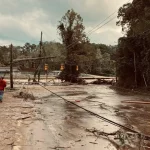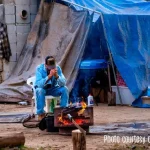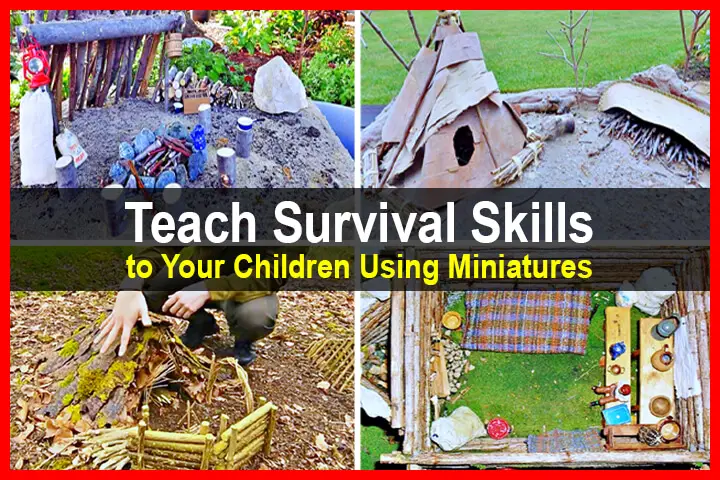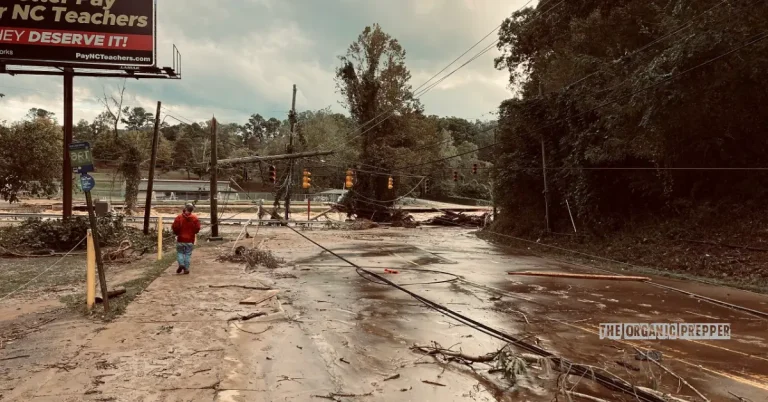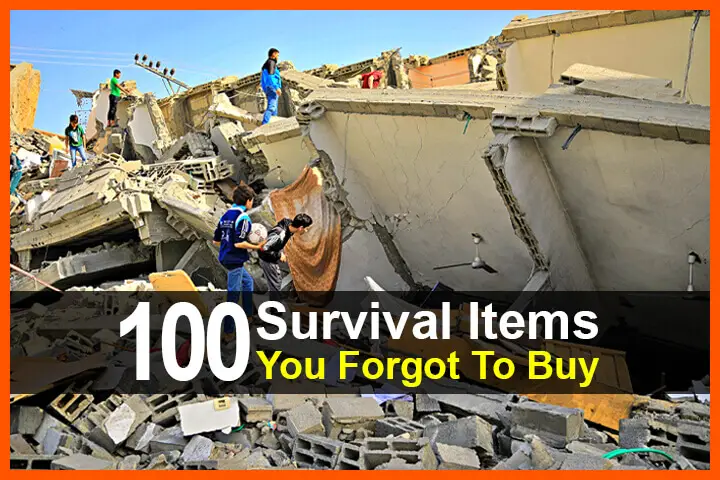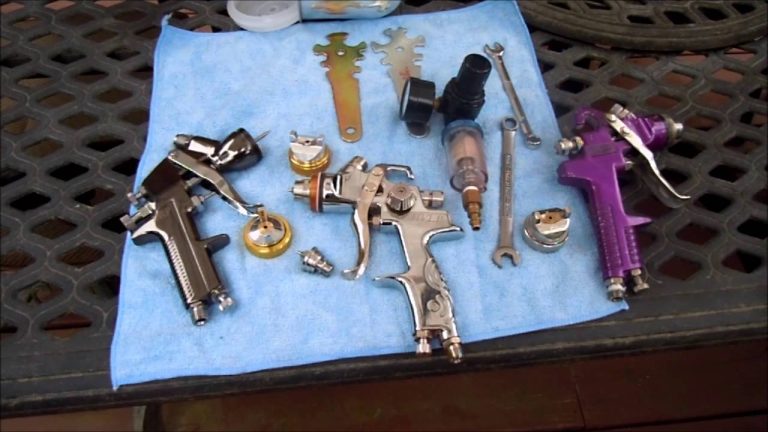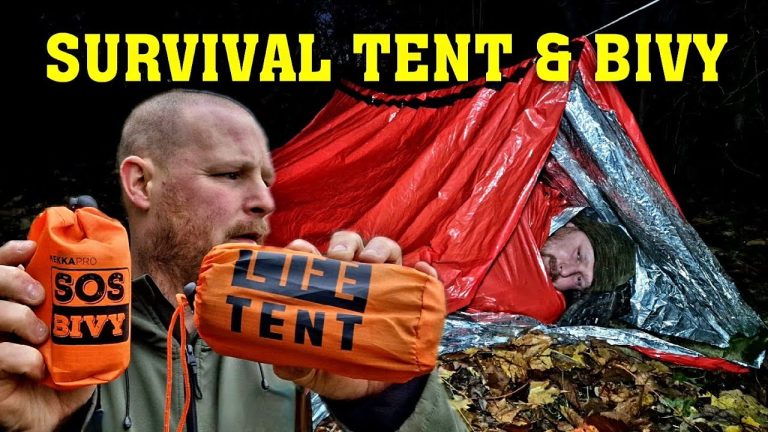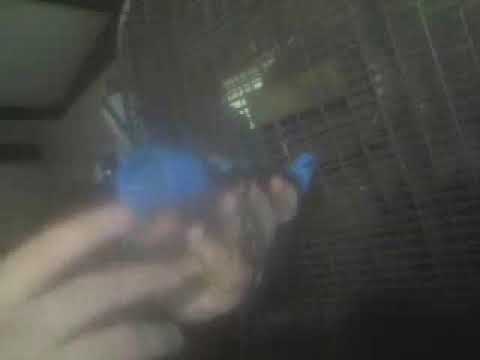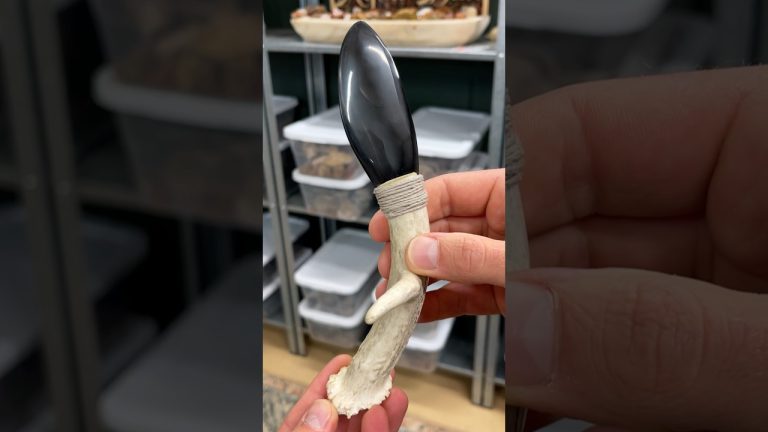Estimated reading time: 21 minutes
Teaching survival skills to kids can be a bit of a challenge. They’re known for their short attention span. Camping is always a possibility and some of the basics about fire-building and finding your way in the woods can be a fun part of the trip. But building a teepee may be more than you or they bargained for after you’ve set up the tent, and some people just don’t have the time.
But there is a way to engage kids in the subject of survival skills and it falls right into their wheelhouse of make believe and imagination: build things in miniature.
Want to save this article for later? Click Here to Pin It On Pinterest!
Miniature Survival 101

This is all about constructing small, scale models of the kinds of things you would construct in a survival situation. That teepee that you were too busy to build on the camping trip will only take 30 minutes in miniature.
Better yet, you can go beyond basic shelters like lean-to’s and teepees and build a fire pit, teach them all the ways to build a fire in miniature; build a spit over the fire to handle some cooking pots, and even craft a miniature canoe out of Birch bark and lean it against your miniature wood pile.
Their Imagination Will Surprise You

As you build your miniature shelters you can ask them what else they might need for their wilderness survival adventure. This is a great way to spark their imagination and make sure you go with whatever they suggest, and ask them how you should all go about building it.
Create a Sense of Place

The great thing about working in miniature is that you can quickly improvise. If you’re working on a slab of wood to define your survival camp, maybe scatter some sand and dirt to create a forest floor or add a small creek at one end for your drinking water. That’s a good way to get on the subject of gathering the water, filtering it and purifying it.
The Sky’s the Limit

It can take months if not a year to build a log cabin in the woods. It would only take an afternoon in miniature, and they’ll have a permanent structure that they can display in their room as you tell them bedtime stories about the deep forest and how they might add to their rustic home in the woods.
It’s an Anywhere/Anytime Approach

If you live in an apartment or condo it may be difficult to get out and set up an actual camp to teach your kids about outdoor survival. Without a yard you’re pretty much dependent on local parks or a road-trip to a remote spot.
Creating miniatures can happen anywhere from the kitchen table to a 14th floor patio. It’s also an all season activity. Snow, cold, rain –there’s a lot that keeps us indoors. Creating a survival camp in miniature can happen at any time of year whether it’s the kitchen floor or a card table in the family room.
The Skills You Can Cover While They Build Their Camp(s)

The things you and the kids will construct in miniature evoke common items you would construct in a real survival camp. As you ask them what they think they’ll need, you can teach them how to build and assemble things in miniature and talk about all aspects related to that task and that need.
? Shelter Types

There are various shelter types from a small piece of fabric stretched over some sticks to make a tent to a classic lean-to, teepee, variations on lean-to’s, igloos, snow forts, and even a log cabin.

As you discuss what they’ll build, ask them what materials they think they’ll need and then work with them to show them how to design and build their first miniature shelter.
? Fire Pit Design

Every survival camp has a fire burning. The usual construction is a circle of rocks to make the fire pit. You could also show them how to build a fire reflector out of sticks or stacked rocks. Talk to them about not using rocks from a lake or river because they could trap steam and explode.
There are also various fire constructions. Teach them how to make a basic teepee fire. Talk about the importance of tinder and kindling. Show them how they could also build a log-cabin fire, an upside down fire for winter, and other fire designs that suit varying conditions and situations.
You could also talk about the various ways to start a fire without matches or a lighter.
? Equipment They Can Make

This is where you can make various pieces of camp equipment like log around the fire for sitting, a tripod from twigs for cooking, a saw horse from sticks for cutting wood, a basic wood pile from small lengths of branches, you could even fashion a hammock from some cloth material, a canoe from birch bark, or anything else they imagine they’ll need in their survival camp –all built in miniature.
? Finding and Purifying Water

If you add a small creek or pond to your little campsite, talk about how they would gather the water, why harvesting water at the source of a creek or spring is the cleanest, how to filter water through a piece of fabric or sand and charcoal, and the importance of boiling water to purify it.
You could also talk about how to capture rain water with a miniature tarp suspended between sticks or small trees you add to your camp. Making the creek is easy with some clear glue.
? Staying Warm and Dry

Talk about ways to stay warm. This is a chance to talk about pine boughs and moss as bedding for the bottom of their shelters to keep them warm and off the ground. Pine needles are also a good, miniature substitute. Talk about how to use pieces of bark as a roof for their lean-to or other shelter to keep the rain and snow out.

And everyone likes it when you cut a thick stick or small branch into logs or rounds that surround the fire so they have a place to sit.
Hobby Lobby Can Be a Great Resource

There’s a section for doll houses in hobby lobby but if you look at it from a different perspective you’ll see it as prepper gear in miniature. They have everything from campfire coffee pots, miniature cast-iron frying pans, tiny lanterns, and just about anything else you’d see in and around a log cabin or survival camp.
Make Some Furniture While you’re at It

This will be easy. Cut a thick branch to about 1-inch long and prop a few around your fire and you’ve got logs to sit on. We’ll call them chairs. You could even improvise some rustic furniture like a miniature log bed frame; make a table out of sticks and bark or scrap wood, make small flour bags from fabric, lash together a tripod with twigs and string and hang one of your miniature cooking pots on the tripod.
The Materials are Basic

You’ll be looking for the same things you would want for a full-scale survival camp, only on a much smaller scale. Here are some thoughts on gathering materials. Do this with the kids and talk about what they think they may need to gather, and encourage them to think about anything they find to help make their survival camps.
Let’s Build a Survival Camp Miniature
It might make sense to cut a board about 1 foot by 2 foot as a foundation for your survival camp. You could also build it on the ground but a board lets the kids hold onto and keep their creations.

Sticks are a main construction material. If you spot twigs with a fork in the branch you’ve got the main support struts for a lean-to. Collect them when you see them and store them in a box for miniature construction day.

Have the kids collect some sand, dirt and crush some leaves to sprinkle on their board to create a natural and wild environment.

Elmer’s glue can also help for creating a diorama. A diorama is the creation of a miniature place. Spread some Elmer’s glue on your board and sprinkle the sand, dirt and crushed leaves and you have a forest floor.

Rocks are another material that you can spread around to create a sense of place, but also put in a circle for your miniature campfire.

Wax string looks like rope and you can use it to teach the kids some basic lashings and knots for cooking tripods, lean-to lashings, or a wooden saw horse made from sticks. You could also find straw or other dry grasses and teach them some of the basics of making cordage from natural materials.

Small, dead branches stuck in the ground around your camp look like trees without leaves and pieces of moss can look like bushes and greenery. If using a board as a foundation, drill into the board and glue the stick-trees into the holes.

The most exotic tool you might need is a hot-glue gun. It works fast and the kids will appreciate that. They’re also inexpensive and you can buy more glue sticks at the dollar store.

Start by having the kids spread the Elmer’s glue around the surface of the board.

Have them sprinkle crushed leaves, dirt and sand over the glue to create a forest floor.

Drill two holes to support your “Y” sticks and have the kids glue them in place.

Place the top bar across the 2 “Y’s.”

Carefully apply some hot glue to the support bar and have the kids lean the sticks against the top support to make their lean-to.

Drill and plant the trees.

Build the fire pit and some twigs for a fire.

Glue some rocks around the camp.

Arrange some camp accessories like a tripod for cooking, cut logs for seats around the fire and anything else you or the kids think of. Here are some ideas to stimulate conversation and learning:
- A wood pile for their fire
- A sawhorse for cutting wood
- A split-rail-design fence around their camp
- A hammock made from a piece of fabric or a rain catcher made from a small piece of tin foil or plastic cut from a plastic bag

Remember to talk with them as you construct your camp and ask them questions about what they think they’ll need or want in camp.

Add some last minute tools and items you may have made or bought at Hobby Lobby. Here are some miniature tools you can make or buy:
- Cooking utensils like frying pans, pots, cauldrons, and coffee pots.Furniture like log rounds cut from branches, miniature tables and benches cut from scrap wood, miniature lanterns.
- Let the kids come up with their own ideas as well.

Sit with the kids and talk about all of the things they’ll need to do in their survival camp and ask them about what they’ll do if it rains, snows, gets cold, or anything else they come up with.

What you’re trying to do is think in miniature for all of the things you might encounter in a survival situation or need to construct for their camp.
Find Pictures for Inspiration

An easy way to think about what you might build with your kids for a survival camp is to simply look at some pictures of actual camps. There are books that cover shelter types and other survival camp items. Re-create what you see or combine ideas in miniature.
If you have more than one child working with you on miniatures, challenge them to each come up with something different. There are numerous variations on shelters, fire pit construction, fire types and builds, and even locations.

Use white sand or white paint to create a winter landscape based on an actual photo, and ask them what they might do different when surviving in the cold. You could even use the snow outdoors in winter to make small shelters in miniature. Then again, they might want to just build the whole snow fort life-size.

Encourage another construction in the desert, or the mountains, or anywhere else you can think of and see if you can spark their creativity for survival solutions in those environments.
Crafting Miniatures in the Grass
If you don’t have the time nor the inclination to build a full diorama, you can build your miniatures in the grass in the backyard. Here’s a simple construction that you can put together in 15 minutes.

This sequence shows the basic steps for a miniature backyard lean-to.
- Gather some sticks but make sure you have a couple that end in a “Y” and one long, thick stick for the primary support.

- Insert your 2 “Y” sticks into the ground opposite each other and put your crossbar support across the top in the “V’s.”

- Have the kids lean more sticks along the crossbar to build their lean-to.

- Finish your camp with a circle of rocks and some twigs in the circle for a miniature fire.

Creating a Sense of “Place” (Diorama)
To create a sense of place, think about where you imaginary camp would be and the time of year. From there you have to think like a model maker or a model railroad enthusiast. They’re expert at creating places and there are some great YouTube videos that demonstrate some basic techniques:
There are also some videos and articles about how to create survival camps in miniature that are worth watching. Watch them with the kids to inspire their miniature construction adventure.

This Could Become a Regular Activity

Once kids understand some of the basic concepts for building in miniature, and after they’ve triggered their imagination with the possibilities –you may find this becomes a regular and fun activity.
In some ways, it’s the fastest and easiest way to engage kids in basic ideas about survival and who knows, someday they may take that cabin miniature out to the woods and actually build a full-scale wilderness retreat.
Like this post? Don’t Forget to Pin It On Pinterest!
